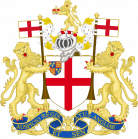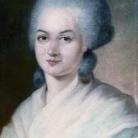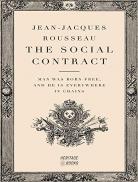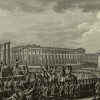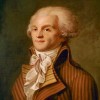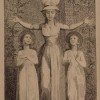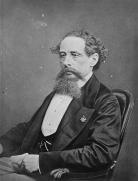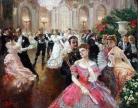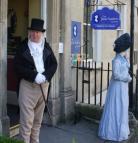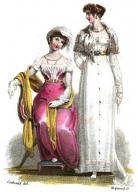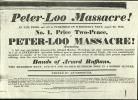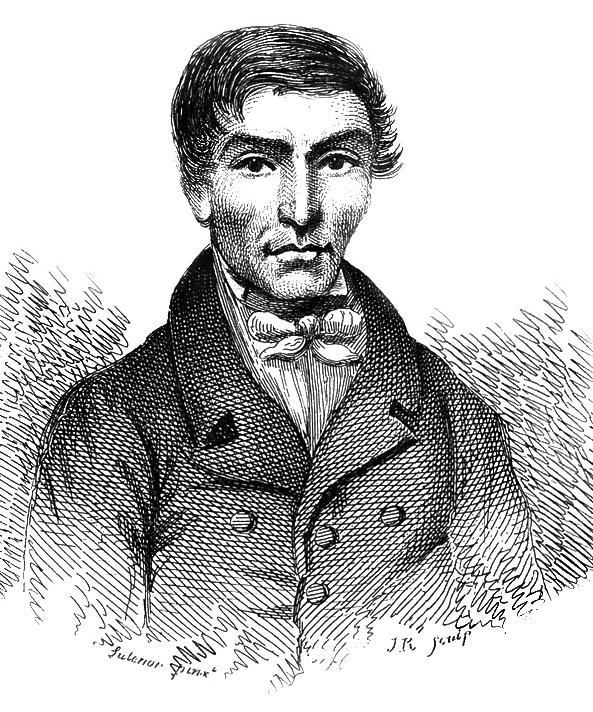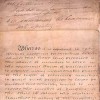Romantic Tensions: A Timeline
Created by Ashley Nadeau on Mon, 01/11/2021 - 14:54
Part of Group:
The Romantic period is unique amongst other literary historical periods; it is neither demarcated by, or named for, the reign a monarch (like the Elizabethan or Victorian eras), nor is it defined by the century with which it coincides (like the Twentieth or Twenty-First Centuries). Instead, the Romantic period is bookended by major political and social events. Named for a literary genre recovered in the eighteenth century (the medieval romance), the Romantic period is generally agreed to have ended in 1832 at the first major reform of the British Parliament, but its beginning could be considered to coincide with a variety of events, such as the 1776 American declaration of independence, or the 1789 commencement of the French revolution. In general, the literature of this period might be characterized as reactionary; Romantic critics and artists were responding to the period’s radical social and political shifts and to the British literary tradition’s overemphasis on classical influences at the expense of other genres and modes of expression. In many ways, they were confronting their own political philosophy, artistic ancestry, and the trauma and turbulence of near-constant war.
This course explores these confrontations through four loosely constructedunits that cover the political debates and artistic innovations fomented by the French Revolution, the challenges posed to gender norms by Romantic women writers, the passionate efforts of abolitionists to raise awareness about the horrors of slavery, and the radicalism espoused by some of British literature’s more (in)famous poets.
Timeline
Chronological table
| Date | Event | Created by | Associated Places | |
|---|---|---|---|---|
| The end of the month Winter 1600 to The start of the month Summer 1874 |
The East India Trading Co.The East India Trading company was a English company that was formed under Queen Elizabeth I. in order to exploit trade with primarily with East/Southeast Asia (specifically India and China). Mechants of Portugal and Spain had created a monopoly over the India Spice trade which England was pining to get their hands on. With England's defeat of the Spanish armada in 1588, they were able to fully monopolize the Indian Spice Trade for themselves. England henceforth began trading in imports such as indigo, cotton, silk, saltpeter, tea, and even slaves. The practice of trading slaves using the East India Trading Co. started in about 1620 and the majority of people exported for the English Slave trade came from East Africa (places like Mozambique and Madagascar). These slaves were transported to English territories in India, Indonesia, as well as the island of St. Helena. The East India Trading Company created an English trading monopoly that acted as an agent in favor of English Imperialism (again primarily in India). The elite who help shares within the East India Trading Company were able to purchase and sway votes within the monopoly giving them ultimate power over English territories and English Trade. Due to the gain in power, the East India Trading Company was able to build extensive control and influence for its shareholders which made the British Government wary. The Editors of the Encyclopedia of Britannica quote the end of the East India Trading Co as follows: "[t]he Regulating act (1773) And the India Act of (1784) established government control of political policy. The company's commercial policy was broken in 1813, and from 1834 it was merely a managing agency for the British Government of India." (Could not add associated places so they were areas in India, East/Southeast China, Northeast Africa, Portugal, and Europe - primarily England). Citation: "East India Company." Encyclopedia Britannica, Encyclopedia Britannica, Inc., 6 Dec, 2020, www.britannica.com/topic/East-India-Company |
Paesly Oswald | ||
| 1664 to 1840 |
Beginnings of Tea in BritainWhile the consumption of tea originated in China, it planted its roots in Britain. Originally, tea was viewed with skepticism from the British, and despite being avaliable all throughout London in 1659, it was not popular. It wasn't until the marriage of Charles II to Catherine of Braganza, that tea was established as a drink of the royal court. Catherine was a Portugese princess as well as a tea addict, and this helped to popularize the drink within the wealthy classes. The East India Trading Company seized the opportunity in 1664 by placing an order for 100lbs of Chinese tea. The popularity of tea grew rapidly from then on, and it was served in over 50 coffeehouses by 1700, and 50 years later was highly favored by the lower classes. In becoming a staple drink for the masses, tea also brought a huge increase in the consumption of sugar, fueled by the slave trade. However, the increase of tea sales meant the decrease of liquor sales, and thus the decrease of liquor tax revenue. The British government led a series of acts that increased the taxation of tea in order to decrease sales, and by the 18th century, the taxation of tea import was at 119 percent. This created a need for tea smuggling, which was led by criminal gangs with brutal methods and no health standards, which often meant that the tea was being cut with anything from sheep dung to copper carbonate in order to keep the color convincing. But, the smugglers were still supported by millions of British tea drinkers. By 1784 the government had had enough, and the tax of tea was cut down to 12.5 percent, making legal tea affordable and smuggling obsolete. The idea of afternoon tea didn't come until later, in 1840, when the seventh Duchess of Bedford would get hungry around 4 pm and request a tray of bread, tea, and cake in order to keep from starving before the evening meal at 8 pm. She made this into a habit, and would invite her friends, and thus the pause for afternoon tea became fashionable. Citations: L, Mary. "The History of Tea in Britain." Topic Tea, https://topictea.com/blogs/tea-blog/history-of-tea-in-britain/. "The History of Tea." UK Tea & Infusions Association, https://www.tea.co.uk/history-of-tea. |
Lindsay Reyes | ||
| 7 May 1748 to 3 Nov 1793 |
Olympe de GougesOlympe de Gouges was born on May 7th, 1748. She was a women's right activist, fought against slavery, and conveyed most of her views through writing. She wrote plays, pamphlets, and stories. A notable document was "French Declaration of Rights for Women and Citizen", a response to the document “The French Declaration of the Rights of Man and Citizen” . These two documents mirror each other in what rights they convey, with de Gouges' putting an emphasis on the fact that women should hold the same rights as men, and should not be pushed aside. She was married when she was sixteen, but after her husband died in 1766 was when she really started to make a name for herself– literally. She changed her name from her birth name of "Marie Gouze" to the much more known name of Olympe de Gouges. It was during this time she started writing, putting a focus on the social issues of the day. She vowed to never marry again, and kept this promise. She and her husband had one son, Pierre. She worked hard for the rights of many groups, not just women. She wrote several plays addressing slavery, fought for the rights of inheritence for children born out of wedlock, and for the legalization of divorce. She wanted equal rights no matter race or gender, but did still support the idea of a king. She wanted France to have a constitutional monarchy, but this view is what led to her arrest and death. She was killed by guillotine on November 3rd, 1793, in Paris, France, for her defense of King Louis XVI. Souces: Image Source: |
Jillian Johnson | ||
| 1762 |
Publication of The Social Contract, by Jean-Jacques RousseauJean-Jacques Rousseau's book, The Social Contract, was first and foremost a politico-philosophical book describing what Rousseau believed to be the best form of government and society. One of Rousseau's main themes, linked very heavily with philosophies during the romantic era, was that society ought to return to a state that more closely resembled the state of nature. Rousseau believed that no one man should have the power to rule, but that by living in close proximity, individuals should govern themselves according to their own rules and laws that have been agreed upon. The points in this book were focused on a direct democracy: one that was run by the entire population (including women, which was a very radical suggestion at that point in time), and one that included small city-states where the government was entirely separate from the actual sovereign (the people). Many of these points were very influencial in social reforms in Europe, including the French Revolution. These ideas also influenced later philosophers like Immanuel Kant and Karl Marx. Source: https://plato.stanford.edu/entries/rousseau/#PrinWorkRous |
Benjamin Maughan | ||
| 1765 to 1805 |
Theater Royal in BathIn 1765 St James Theatre was granted a Royal Patent, making it the first provincial Theatre Royal in not only Bath but England. There were many plays that took place in this building, such as "King Richard the III", "Macbeth", and "The Grecian Daughter". The theatre became so popular that the tickets were selling out every night and therefore more space was needed. At this time, in 1805, a new building was put up. This building has a direct correlation with one of Jane Austen's popular books, Northanger Abbey. "Austen scholars are generally of the opinion that [a] scene takes place in [Northanger Abbey] that takes place in [the Theater Royal in Bath]. This is because "Jane Austen visited Bath several times in the late 18th Century... She was a regular visitor to the Theatre Royal in Orchard Street during the last five years of its existence". It is believed that she "used the interior as a backdrop in her novel Northanger Abbey". The citation from Northanger Abbey: At the beginning of the fifth, however, the sudden view of Mr Henry Tilney and his father, joining a party in the opposite box, recalled her to anxiety and distress. The stage could no longer excite genuine merriment — no longer keep her whole attention. Every other look upon an average was directed towards the opposite box; and, for the space of two entire scenes, did she thus watch Henry Tilney, without being once able to catch his eye... suggests a setting that directly reflects that of the Theatre Royal in Bath. Scholars argue that "The side boxes at the lower level each side of the Theatre had seats (the upper two levels were standing galleries), and Austen scholars are generally of the opinion that this scene takes place in them, probably because Miss Austen’s actual situation in society would most likely place her attendance there. However, at the time the book was written, the Theatre also had grand boxes at the upper rear, arranged in a semi-circle with the two extreme boxes also facing each other. The social (and financial) status of the fictitious Allens and Tilneys would have made these boxes more likely of their patronage". Citations: “Theatre Royal 1750 - 1805.” Old Theatre Royal Tours & Masonic Museum, oldtheatreroyal.com/museum/theatre-royal-1750-1805/ |
Melissa Strange | ||
| 5 May 1789 to 10 Nov 1799 |
French Revolution
On 5 May 1789, the Estates-General, representing the nobility, the clergy, and the common people, held a meeting at the request of the King to address France’s financial difficulties. At this meeting, the Third Estate (the commoners) protested the merely symbolic double representation that they had been granted by the King. This protest resulted in a fracture among the three estates and precipitated the French Revolution. On 17 June, members of the Third Estate designated themselves the National Assembly and claimed to represent the people of the nation, thus preparing the way for the foundation of the republic. Several pivotal events followed in quick succession: the storming of the Bastille (14 July), the approval of the Declaration of the Rights of Man and of the Citizen (26 August), and the march on Versailles that led to the enforced relocation of the royal family to Paris (5-6 October). These revolutionary acts fired the imagination of many regarding the political future of France, and, indeed, all of Europe. The republican period of the revolution continued in various phases until 9-10 November 1799 when Napoleon Bonaparte supplanted the government. ArticlesDiane Piccitto, "On 1793 and the Aftermath of the French Revolution" |
Dave Rettenmaier | ||
| 1 Jan 1792 |
Vindication of the Rights of Woman
ArticlesAnne K. Mellor, "On the Publication of A Vindication of the Rights of Woman" Related Articles |
Dave Rettenmaier | ||
| 21 Jan 1793 |
Execution of King Louis XVI
1793 was a key juncture in the revolution, beginning with this execution on 21 January. The increasing violence prompted Britain to cut its ties to France, leading to declarations of war by the two countries. Violence peaked during the Reign of Terror (5 September 1793 – 27 July 1794), which resulted in the execution of the Queen (16 October) as well as of many suspects of treason and members of the Girondins, the more moderate faction that the radical Jacobins brought down on 2 June 1793 ArticlesDiane Piccitto, "On 1793 and the Aftermath of the French Revolution" |
Dave Rettenmaier | ||
| 5 Sep 1793 to 27 Jul 1794 |
Reign of Terror
On 5 September 1793, the National Convention, France’s ruling body from 1793 to 1795, officially put into effect terror measures in order to subdue opposition to and punish insufficient support for the revolution and the new regime. From the autumn of 1793 until the summer of 1794, thousands of people across the country were imprisoned and executed (including the Queen) under the ruthless leadership of Maximilien Robespierre. The guillotine, particularly the one in Paris’s Place de la Révolution, served as the bloody emblem of the fear tactics that began to manifest themselves first in the formation of the Committee of Public Safety (6 April 1793) and subsequently in the implementation of the Law of Suspects (17 September 1793). The Terror ended on 27 July 1794 with the overthrow of Robespierre, who was guillotined the next day. ArticlesDiane Piccitto, "On 1793 and the Aftermath of the French Revolution" |
Dave Rettenmaier | ||
| 10 Sep 1797 |
Death of Wollstonecraft
ArticlesAnne K. Mellor, "On the Publication of A Vindication of the Rights of Woman" |
Dave Rettenmaier | ||
| Jan 1798 |
Memoirs of the Author of a VindicationOn January 1798, publication of William Godwin’s Memoirs of the Author of A Vindication of the Rights of Woman. The publication of this first biography of Wollstonecraft causes a scandal and Godwin publishes a second “corrected” edition of the Memoirs in the summer of the same year. ArticlesRelated ArticlesAnne K. Mellor, "On the Publication of A Vindication of the Rights of Woman" |
Dave Rettenmaier | ||
| 5 Nov 1798 to 16 Apr 1870 |
MARIE-CAROLINE, DUCHESSE DE BERRYOn November 5, 1798, Marie-Caroline was born a princess of Sicily and Naples of the House of Bourbon. She later married into the French Royal to which she spent a lot of time dedicating herself to the arts. According to the Fashion History Timeline website, “she arrived in France in 1818 determined to be a leader in all things, from art to literature and music, to fashion” (Harper). Although she was forced into exile in 1830, Marie-Caroline spent lots of time before then studying and appreciating the arts. She especially spent time over the art of fashion. It is interesting to see the progression of Romantic fashion from Gothic through the influence of Marie-Caroline, especially as we finished Northanger Abbey. The book has lots of influence from the Gothic and so did Marie-Caroline’s fashion. Her appreciation for fashion is a great reflection of the change from the gothic to the romantic era. She found an appreciation for the fashion of the past, “Marie-Caroline’s fashion choices reflected the Romanticism of the era, particularly the fascination with the past. Both her clothing and her ever-expanding collection of art were often in the French style troubadour, an offshoot of Romanticism, defined by idealized depictions of the Middle Ages and the Renaissance” (Harper). In her time in French royalty, she would through costume balls “making a fashion of the old Gothic or Renaissance heritages, and leading a [trend] to exoticism, with her Persian and Turk balls” (The Mother). Marie-Caroline was a fashion icon with her renaissance-styled clothing and with this, a lot of the Romantic period fashion had an obsession with the past. One moment that had lots of influence on Romantic fashion having an obsession with the past was La Quadrille de Marie Stuart. This was a ball hosted by Marie-Caroline in 1829 that is shown through a series of lithographs by Eugene Louis Lami. “The costumes from La Quadrille de Marie Stuart, as it came to be known, were reported in the fashion press and undoubtedly reinforced the 1820s obsession with the past” (Harper). Citations: The Mother-of-Pearl Fan of Marie-Caroline, Duchess of Berry. madd-bordeaux.fr/en/month-object/mother-pearl-fan-marie-caroline-duchess-berry. Franklin, Harper. “1820-1829.” Fashion History Timeline, 27 May 2020, fashionhistory.fitnyc.edu/1820-1829/#:~:text=century%2C%20decade%20overview-,OVERVIEW,styles%20borrowed%20from%20past%20centuries. |
Abigail Jensen | ||
| circa. 1800 |
Victorian LinguisticsThe 1800’s is when English truly blossomed into what we consider “iconic victorian” linguistics. This type of English is much closer to modern English and as such makes it much easier to “interpret”. Reading novels from this time period is much easier than, say, Shakespeare. Another reason that it tends to be easier to read is that grammar had solidified much more at this point. Some commonly used words during the Victorian era had more of a Latin root or polish to them. Here’s the history of some of my favorite Victorian vocabulary words, you may notice words on this list are common even today but they were even more common vernacular in the Victorian era. Cupidity -- an inordinate desire for wealth (derived from the Latin word Cupere -- to desire) Pecuniary -- Consisting of or measured in money (derived from the Latin word Pecuniam -- Money) Character -- (in the Victorian sense) A person of renown and polish These are just a few of my favorite words that I will be highlighting. One of the authors that was best known for Victorian linguistics (aside from Austen) is Charles Dickens who lived from 1812 to 1870. When I began my research on this topic I found more about his particular linguistic style in the Victorian Era than almost any other author. I had never considered his works to be Victorian before because they are so palatable. But I suppose that’s simply because the language was more palatable than Shakespeare and other classical authors of the time. |
Cheyenne Ingalls | ||
| circa. 1800 to circa. 1920 |
Balls during the Romantic PeriodThere were many different types of balls, such as charity balls (fundraisers), balls organized by societies and associations, costume balls (rare, but popular), and debutant balls (young women were presented to society) but only high society was invited to these events. There were many manuals printed to inform high society on the appropriate behavior when hosting a ball. For example, "the 1866 British manual The Ball-Room Guide gives advice on how to draw up the invitation list to a private ball. We are told, for example, that one should generally invite more people than can comfortably be accommodated because it's rare that everyone invited will show up. And to ensure that the dance floor is filled, one should invite more men than ladies" The acceptable dress may seem obvious, women in a ballgown and men in a black suit or tailcoat, however, there was more to it than that. The men must also wear a white tie and white gloves. However, cream or ivory gloves were also acceptable. The women must wear long gloves and slight heels. Exposed shoulders were encouraged, and a Lady must carry a fan and a dance card with her. The fan must be made from ivory or mother-of-pearl. The fan was used as a form of communication, "[d]epending on whether it was closed, open or fluttering, it could convey a refusal, interest or excitement". Citation: Rousseau, Karine. “Balls (In the 19th and Early 20th Centuries).” Balls (In the 19th and Early 20th Centuries) | Thematic Tours | Musée McCord Museum, McCord Museum, collections.musee-mccord.qc.ca/scripts/explore.php?Lang=1&tableid=11&tablename=theme&elementid=83__true&contentlong. |
Melissa Strange | ||
| 1801 to 1806 |
Jane Austen's time in BathSo much of what we know about Jane Austen's opinion of her time in Bath is colored by her negative comments of it in letters and her writing. Indeed, even my first COVE post for Bath on the map talked about the different experiences for Jane in Bath from when she visited versus when she lived there with her parents. But I found an interesting article that goes into a lot of the contradictions of Jane saying she hated Bath related to some of her experience there. First, it should be noted that her move to Bath in 1801 was a decision by her parents who were retiring there, in part because of her mother's health needs. At first she was horrified, and Jane Austen scholars know that this makes sense given the general themes of home, smaller village life and a general distrust of city life in her writing. But as the Jane Austen scholar Paula Bryne points out, "Austen’s residence in Bath in the years 1801-06 coincided with one of the most prosperous and exciting times in the history of the local stage" (17). But not just with the stage, but with the culture there in general. While Austen was critical of the stage (we can see this in Mansfield Park), Bryne points out all the mentions in letters and journals by Austen that she often went to the theater and even had a favorite actor. Some of the aspects of Bath during that time can be found in the newspapers of the time. Forgive the longer quotation, but I find it helps color what Bath was like during this time for Austen. "Amongst the advertisements for tooth whitening, false hair, lotions for the face to reduce freckles, muslin dresses trimmed with lace; between the countless medical cures for rheumatism, gout, sprains, bruises, and women’s ailments (the celebrated Cordial of Balm of Gilead, curing wind in the stomach and the bowels, and all nervous complaints), [Jane] would discover an array of enticing urban pleasures for the discerning tourist or civilized inhabitant. Tickets for the Assembly rooms were on offer, boxes at the Theatre Royal, musical concerts, and of course the pleasure gardens with fireworks and illuminations" (16). Between all of that and the balls, it's clear that Bath was the social center of society for a lot of people. But how are we supposed to truly see Jane's experience when we have accounts like these: “Here I am once more in this Scene of Dissipation & vice, and I begin already to find my Morals corrupted” (17), but also like this (referring to her favorite stage actor perhaps leaving Bath and being quite worried about it): "Elliston . . . has just succeeded to a considerable fortune on the death of an Uncle. I would not have it enough to take him from the Stage" (18). I argue that we can see how she truly feels with her writing. Home and leaving home is a major theme in many of her novels, and while there does seem to be genuine enthusiasm behind Catherine's love of Bath in Northanger Abbey, her later works and how they often view moving around as a lack of stability. Indeed, Susan Morgan argues that this reflects Jane's life, in that her moving to Bath and then moving around quite a bit with her mother after her father's death wasn't ideal. She says, "all this changing around hardly adds up to a stable, in the sense of settled and static, domestic universe as the geographic setting of Austen’s work" (2). Given that much of the drama of her works lies in the nuances of the more settled domestic universe, it's clear to see that while Jane may have found Bath exciting and diverting, there may not be as much time for nuance either. Works cited: Byrne, Paula. “‘The unmeaning luxuries of Bath’: Urban Pleasures in Jane Austen’s World.” Persuasions 26 (2004): 13-26. Morgan, Susan. “Adoring the Girl Next Door: Geography in Austen’s Novels.” Persuasions On-Line 21.1 (2000).
|
Jacob Gibson | ||
| 1811 |
Women's Social Etiquette: The Mirror of GracesThe Mirror of Graces, or also known as The English Lady's Costume: Combining and Harmonizing Taste and Judgement, Elegance and Grace, Modesty, Simplicity and Economy, with Fashion in Dress. That is the title of a book written by a mysterious author whose pen name is "The Lady of distinction". Written in 1811, this book does more than examine women's fashion. It's a book about social presentation, etiquette, and class. This book would be equivalent today to a beauty magazine aimed at young girls. It's comprised of sections: dress, hair, cosmetics, airs, dancing, presenting oneself, etc. All the ins and out of what a woman had to do to remain ideal and desirable in a world where marriage was a must. If a socialite woman did not marry at this time, it was expected she dedicates her life to charity. The book has a guide, giving a preface to the contents of each chapter. This is the preface for the first. "CHAPTER I. Preliminary observations on the subject. --Opinions of the Epicureans and Stoics on the dignity of the human body. - Characteristics and purposes of the human form . - The sentiments of true philosophy on the subject. — On female charms, their use and abuse. — Taste. - Beauty.-- Affectations. - Modesty .- Grace.- Simplicity. —Girls. -Women . — Religion and morality. – Virtue. Amenity of manners . — Duty to a husband. Beauty reflecting virtue. -General influence of women over men."This gives you an idea of what fills the 289 pages. I'll list a few educational examples of ladies social etiquette and expected presentational demeanor that I think you'll find interesting, by paraphrasing of course. These might not be things you've heard of before, as they are small snippets from a large book. In chapter 3, The Lady of distinction writes that there are three rules, advise women, to follow if they wish to keep their youthful appearance and ladylike mannerisms. Rule 1: Temperance. A girl shouldn't eat too much when she's at the table, no should to partake in too many midnight balls or outing to the theater or other parties. Rule 2: Gentle and daily exercise in outdoor air. This should be done with walks in the gardens or horseback rides, or even resting in a carriage- as long as one gets out! The outdoor air is great for calming one's nerves. This should absolutely not be done under the summer midday sun when it's too hot, or in the evening when you can catch a cold. Rule 3: Cleanliness. A woman should take baths and often! A washbasin is not enough for all the dirt and disease England has. A child's cold and the paralysis of the elderly could all be but cured if they bathed more. A bonnet should be worn when going out. A woman shouldn't be unveiled, as her skin and hair are at the mercy of nature all around. The current habit (in 1811, of course) of going out unveiled will be damaging to the ladies and should cease. A woman who wears diamonds or pearls or expensive jewelry in the morning, is in short, tacky. Always wait to be introduced to a man, as it's his honor to meet you. Likewise, anyone of lower station should be introduced to you. When a young lady sits to play an instrument, or sing a new Italian song, she should not twist or contort her body, swing her head back and forth, roll her eyes this way and that. She should remain calm and poised, effortless in her performance. At the end of the book, there is a list of instructions and recipes for face-masks and other beauty tips.: "A Paste for the Skin . [ This may be recommended in cases when the skin seems to get too loosely attached to the muscles. ] Boil the whites of four eggs in rose water, add to it a sufficient quantity of alum ; beat the whole together till it takes the consistence of a paste . This will give, when applied , great firmness to the skin." Here is a PDF link to the full book: The Mirror of the Graces |
Samantha Eborn | ||
| 18 Jun 1815 |
Battle of WaterlooThis battle was fought in Waterloo, Belgium on June 18, 1815. This is an important battle as it is the battle in which Napolean was defeated, thus ending his expansion plans for his empire. In this battle, Napolean fought against an army with soldiers from all over Europe, including but not limited to, the UK, Prussia, and the Netherlands. The reason he lost was due to a critical strategy error on Napolean's part. He waited until midday to order his troups to attack the enemy, after waiting for the waterlogged battleground to dry up more. Because of this, the forces Napeolean was fighting had time to get fortification with nearly 30000 more soldiers coming to aide in the fight against the French. It was because of this that Napeolean did not have enough forces to survive fighting against his enemies, and by the end of the day he had lost. This battle signified the end of his 100 day long march in which he expanded his control and power, taking over areas surrounding France in order to grow his empire. Source: https://www.history.com/topics/british-history/battle-of-waterloo |
Jade Davis | ||
| Dec 1815 |
Emma
ArticlesAnne Wallace, “On the Deceased Wife’s Sister Controversy, 1835-1907″ |
Dave Rettenmaier | ||
| circa. Summer 1816 to circa. 1823 |
Mary Shelley Writes and Publishes "Frankenstein"Locked indoors due to a rainstorm in 1816, Mary Shelley, along with her husband, Percy, and their friend, Lord Byron, had a ghost story competition. Impressed by the story Mary told based off a dream she had had, Lord Byron and Percy encouraged her to write it down. Shelley finished writing in summer of 1817, and published Frankenstein or The Modern Prometheus on January 1, 1818 anonymously due to fear of how the public would receive a novel written by a woman as well as the philosophical ideas contained therein that challenged Romantic ideals of beauty and nature. It wasn't until the second edition of the novel in 1823 that Shelley revealed herself as the true author, however, despite scholars' admissions to the contrary, rumors spread that Percy had written Frankenstein instead of Mary, and some of these rumors persist even still today. This is due in part to Percy's involvement in the writing by offering corrections and revisions in her notebooks, though that is all they were. Indeed, much of the ongoing conversation regarding Mary Shelley refuses to discuss Shelley in her own right and instead focuses on her relationship with Percy, or her mother's or father's literary accomplishments, or even stories critics claim to have inspired her iconic monster (such as the Greek myth of Pygmalion). The fact remains that Mary Shelley authored Frankenstein and is (at least in part) responsible for the birth of modern science fiction as we know it today. |
Emily Probst | ||
| 16 Aug 1819 |
Peterloo MassacreThis massacre started as a protest, and it was a "culmination of a series of political rallies held in 1819, a year of industrial depression and high food prices" (Britannica). Around 60,000 working class people (men, women, and children) marched to St. Peter's Field "to demand political representation" (Pidd) since at that time, only wealthy landowners were able to vote. Their protest was peaceful until some rich citizens paid for a private band of soldiers to attack the crowd. At least 11 people were killed with an estimated five to six hundred injured as a result. The exact number of people murdered is debated--some say that 18 people were killed, including an unborn child. Within ten minutes, the area was clear except for the dead (Britannica). The protestors were motivated into action by a number of events. First of all, the end of the Napoleonic wars created a poor economy with thousands of soldiers returning home from fighting and in need of a job. Finances had also taken a massive hit, and there just wasn't enough jobs and money to go around. Secondly, a lot of these working citizens' jobs had been taken over by machines that could get the job done faster, better, and cheaper for the employers. A lot of factories also shut down with short notice because of "trade slumps" (Pidd). These people wanted to vote so they could improve both their lives and the economy. The radical leader of this group was Henry Hunt. He came out of the massacre uninjured, but his hat had been pierced with a sword, which became the symbol for reform. Hunt was later arrested and imprisioned for his views and beliefs. What came of it? The Peterloo Massacre "paved the way for parliamentary democracy and particularly the Great Reform Act of 1832" (Pidd). It sought out to give the working class the right to vote, and it eventually helped make that happen. Information sources: “Peterloo Massacre.” Encyclopædia Britannica, Encyclopædia Britannica, Inc., www.britannica.com/event/Peterloo-Massacre. Pidd, Helen. “The Peterloo Massacre: What Was It and What Did It Mean?” The Guardian, Guardian News and Media, 16 Aug. 2019, www.theguardian.com/uk-news/2019/aug/16/the-peterloo-massacre-what-was-i.... Image source: Archives+, Manchester. Advertisement for an Account of the Peterloo Massacre. 6 Feb. 2019, www.flickr.com/photos/55918222@N02/32065014037. |
Tiffany Howard | ||
| circa. 1820 to circa. 1825 |
Women's Fashion Change in the Romantic PeriodBeginning in 1820, Women’s fashion began to change from the Empire style which had dresses waistline falling an inch or two below the bust and having slightly puffy sleeves. Empire style also included gores, which are triangular-shaped segments made to create a flaring effect on a dress. Between 1820-1825 Women’s fashion continued to hold most of the Empire-style designs as the only change was the waistline dropping a few inches and the sleeves getting puffier. Susan Jarrett, a historical fashion blogger, described the early 1820s fashion as “a transition period between the former Empire style and the new Romantic style. During this period, the waistline slowly descended back to its normal position as skirts gradually increased in fullness. Skirts of the 1820s were typically gored– or cut in an A-shape with the narrowest part of the skirt near the waist slowly increasing in width as the skirt progressed to the hem” (Jarrett). Around this time, Romantic period fashion had a dropped waistline, puffy sleeves, and widened skirts that still had gores. However, in 1825 the romantic fashion went through a dramatic change as the waistline continued to drop until it was at the natural waist in 1825. “As the waistline dropped, the skirt and sleeves widened; by 1825, the early Romantic silhouette was established with a natural waistline, large puffed sleeves, and a wide skirt with an increasing number of gore” (Franklin). As the waistline dropped, the sleeves and skirt continued to widen. Around 1827, instead of having gores, skirts were pleated at the waistband to create a cinched waist effect. As well as this, intricate designs of twisting fabrics were added to the hem of dresses, making them much heavier. Dresses went from having a high waistline, puffy sleeves, and much more flowing material to cinched waists resting on natural waistlines, puffier sleeves, and heaving skirts that included intricate, fabric designs.
Works Cited: Franklin, Harper. “1820-1829.” Fashion History Timeline, 27 May 2020, fashionhistory.fitnyc.edu/1820-1829/#:~:text=century%2C%20decade%20overview-,OVERVIEW,styles%20borrowed%20from%20past%20centuries. Jarrett, Susan. “The Romantic Era 1820-1850.” Maggie May Clothing- Fine Historical Fashion, 14 June 2020, maggiemayfashions.com/calicoball/fashionhistory/the-romantic-era-1820-1850/. |
Abigail Jensen | ||
| circa. The end of the month Autumn 1820 to circa. The end of the month Autumn 1820 |
John Keats is Quarantined in the Bay of Naples"A Letter from Quarantine." John Keats, the twenty-five year old poet, made a mad dash for the shores of Italy following his discovery of consumption in his lungs. In centuries past, it was believed that the warmth of the beach would heal the lungs, and after waking up to a splotch of blood on his pillow, Keats was desperate. His voyage trailed in the wake of a cholera outbreak in Britain, and he fled one country only to arrive in a ten-day quarantine in Naples. Despite his obvious unrest, historians praise this quarantine, as it produced a lot of Keat's famous, last work before his death a mere four months later. He wrote of his upbringing, and how almost every person dear to him had died. This, paired with the hatred of his fellow poets (Lord Byron once related Keat's work to a sort of 'mental masturbation') would have accounted for his melancholy. In this quarantine, he wrote; Bright star! would I were steadfast as thou art —
Not in lone splendor hung aloft the night. . .
Another notable poem in this time of his life said,
… mortality / Weighs heavily on me like unwilling sleep.
Keats, like the people of 2020, found himself in quarantine due to an infectious virus. While it was nearly two centuries ago, it is easy to find the similarities in his final sparks of thought and in those of modern day.
Mayes, Frances. “When the World Stops, Traveling in John Keats's 'Realms of Gold'.” The New York Times, The New York Times, 26 Mar. 2020, www.nytimes.com/2020/03/26/travel/coronavirus-essay-mayes-keats.html.
|
Abby Dewsnup | ||
| Winter 1827 to 31 Oct 1828 |
William Burke & William Hare Murder Spree“Burking” is a verb meaning: “to murder, as by suffocation, so as to leave no or few marks of violence” (Dictionary.com). The term originates from William Burke, a 19th century serial killer who, along with his accomplice, William Hare, “murdered at least 16 people in Edinburgh, in order to sell their fresh bodies to the anatomist Robert Knox” (Tarlow 216). The murders took place in 1828 which was 77 years after the passage of The Murder Act which made it legal to dissect and study the bodies of executed criminals for the sake of anatomical research (Gül and Sahinoglu 128). The legacy of this act, of course, can be seen in Mary Shelley's Frankenstein, as Victor primarily uses just such bodies to construct his creature. Eventually, though, the demand for corpses became greater than the supply, and the trade of the “Resurrection Men” (Evans 1190), who were essentially just graverobbers that sold the bodies they dug to anatomists, became rather lucrative. William Burke and William Hare “knew of grave robbers and would have robbed graves themselves; however, they found it too hard and dangerous” (Gül and Sahinoglu 130), so they instead opted to go on a murder spree. Said spree began when Hare’s renter died (of natural causes) and Hare and Burke decided to sell his body to Dr. Knox, who was one of Scotland’s most successful professors of anatomy at the time (Gül and Sahinoglu). After being paid for their first body and seeing how much money they stood to gain, the pair “[enticed] at least 15 unknown wayfarers into the lodging house, where they got them intoxicated and then smothered them” (Jenkins 1) and sold their bodies. Eventually, the disappearances of their victims began to attract attention, and they were caught. Their trial took place on Christmas Eve, 1828 (Evans 1190). Hare turned against Burke, testifying against him in exchange for immunity (Tarlow 216), and Burke was subsequently hung on January 28, 1829 (Evans 1190). Despite the unfortunate fact that Hare does not seemed to have paid for his crimes at all, karmic justice was at least served for Burke, when, following his execution, his body was “sent for anatomical dissection” and it was “[subjected] to the same fate as those of his victims” (Tarlow 216). These murders were especially significant, because they “caused a national furore of fear and anger, which became known as Burkophobia” (Richardson 161) and this “furore” eventually led to the passage of the Anatomy Act of 1832, “which decreed that the bodies of unclaimed paupers who had died in elderly care homes and hospitals be given to licensed anatomists for dissection” (Gül and Sahinoglu 128). Even this act, however did not rectify the body shortage, which would persist until WWII (Richardson 161).
Works Cited “Burke.” Dictionary.com Unabridged, Random House INC, 2021, https://www.dictionary.com/browse/burking. Accessed 1 April 2021. Evans, Alun. “William Hare the Murderer.” International Journal of Epidemiology, vol. 39, no. 5, Oct. 2010, pp. 1190–1192. EBSCOhost, search.ebscohost.com/login.aspx?direct=true&db=edb&AN=55117913&site=eds-live. Gül, Senay and Sahinoglu, Serap. “Mystery of Anatomy: Robert Knox.” Anatomy: International Journal of Experimental & Clinical Anatomy, vol. 13, no. 2, Aug. 2019, pp. 126–135. EBSCOhost, doi:10.2399/ana.19.062. Jenkins, John Philip. "William Burke and William Hare.” Encyclopedia Britannica, 27 Jul. 2011, https://www.britannica.com/biography/William-Burke-and-William-Hare. Accessed 1 April 2021. Richardson, Ruth. “Human Dissection and Organ Donation: A Historical and Social Background.” Mortality, vol. 11, no. 2, May 2006, pp. 151–165. EBSCOhost, doi:10.1080/13576270600615419. Tarlow, Sarah. “Curious Afterlives: The Enduring Appeal of the Criminal Corpse.” Mortality, vol. 21, no. 3, Aug. 2016, pp. 210–228. EBSCOhost, doi:10.1080/13576275.2016.1181328. |
Talyn Torres | ||
| 1 Apr 1829 |
Roman Catholic Relief Act
The Catholic Relief Act of 1829 allowed Catholics to become Members of Parliament and to hold public offices, but it also raised the property qualifications that allowed individuals in Ireland to vote. The passage of the Catholic Relief Act marked a shift in English political power from the House of Lords to the House of Commons. The Act was led by the Duke of Wellington and passed despite initially serious opposition from both the House of Lords and King George IV. ArticlesRelated ArticlesCarolyn Vellenga Berman, “On the Reform Act of 1832″ Sean Grass, “On the Death of the Duke of Wellington, 14 September 1852″ |
Dave Rettenmaier | ||
| Jun 1832 |
Reform Act
ArticlesCarolyn Vellenga Berman, “On the Reform Act of 1832″ Related Articles |
Dave Rettenmaier |

